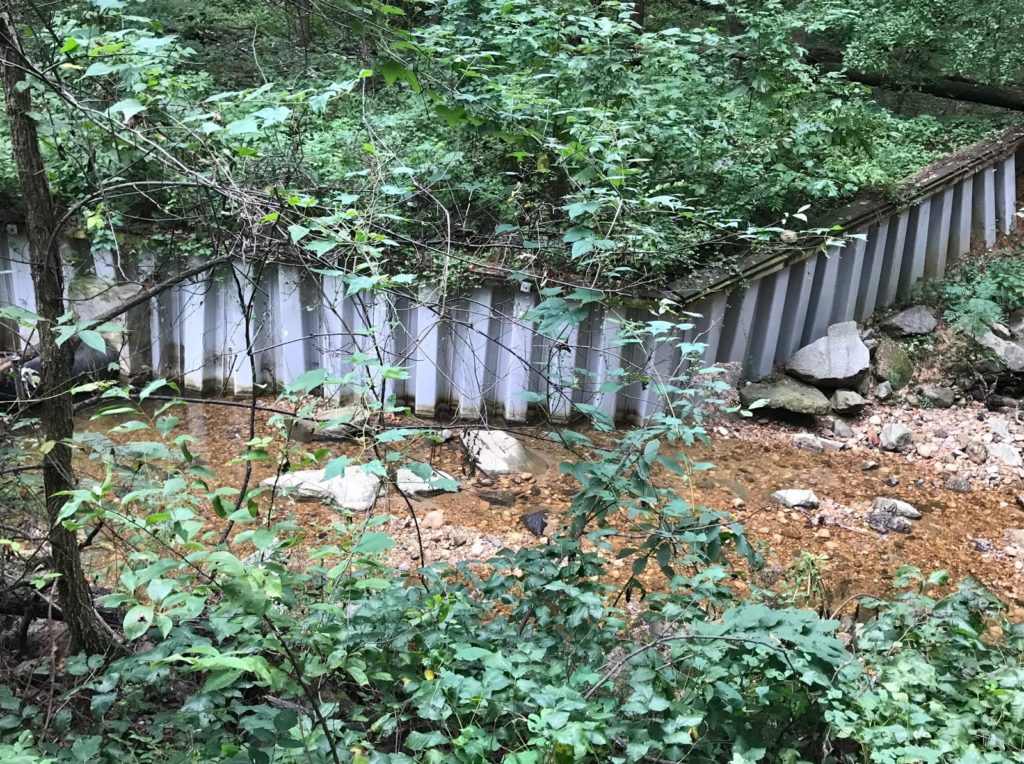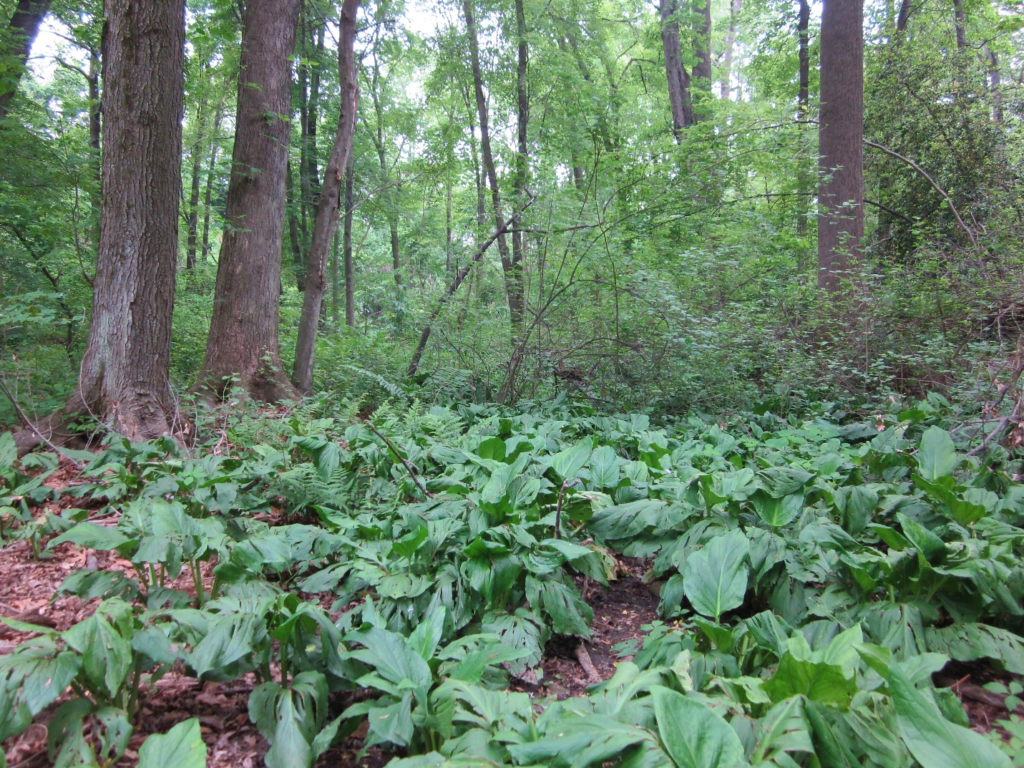Peter Rizkallah, Guest Contributor
What is the Taylor Run Stream Restoration Project?
Taylor Run flows along the Chinquapin Park trail near T.C. Williams High School. It drains into larger bodies of water, including the Potomac River and the Chesapeake Bay.

The area is an important landmark in Alexandria because of the unique flora that inhabit it: royal ferns, eastern serviceberries, white turtleheads, cinnamon ferns, to name a few. There are many animal species such as aquatic insects that thrive in Taylor Run including the mayfly and caddisfly larvae. Taylor Run is also home to many ancient trees that contribute to the stability of the stream and the wildlife in the area. These trees are very special to Alexandria because they will soon be 100 years old. It is important for these trees to remain intact as they are integral to the ecology of the area.

However, the city is proposing a project that may take this away. It has a mandate to reduce daily levels of nitrogen, phosphorus, and sediment pollution that reach the Potomac River and the Chesapeake Bay. The city has conducted multiple stream assessments in the form of phases in 2004, 2008, and more recently, 2019. The area that has been assessed is approximately 2,800 linear feet.
According to the city’s consultants, “The stream corridor is highly disturbed with severe erosion in various locations along the stream with evidence of downcutting and widening at various locations.” They also assert that the “excess sediment and phosphorus are polluting the Chesapeake Bay and are causing erosion in the creek.” However, there is not sufficient evidence from the city to prove that the water quality is poor. Although the city’s intentions for this project may be positive, it has not provided the data that qualifies the stream as a restoration site. With this in mind, will the project cause more harm than good?
What Will the Project Impact?
The Taylor Run Stream Project has repercussions associated with its design. The existing flora and fauna in the area will be severely affected by the construction around the stream. AP Environmental Science teacher Lexye Hearding said, “We will lose over 200 trees and many unique species that live in the acidic seepage bog. If they make the creek more shallow, the acidic bog will be inundated with fresh water, which will affect the plants that are adapted to that acidic environment.”
Many flora are in danger of being exposed to new conditions that the stream would present.. Hearding even suggests the possibility of invasive species using the construction to colonize the adjacent acid seepage swamp. Clear-cutting hundreds of trees and bulldozing this narrow ribbon of greenery will certainly pose a hazard to the wildlife, which consider Taylor Run home. Experts on the stream restoration have suggested how to evaluate a stream restoration like the Taylor Run Project.
John Field, a fluvial geomorphologist and restoration specialist, has investigated the Goodman and Brickelmaier streams in Fairfax County, which are also being considered for restoration. His findings have proved to be very significant and similar to that of the Taylor Run Project. “In my view,” said Field, “projects completed on rivers and streams can rightfully be called “stream restoration” only if they achieve all of the following three things: 1) they move the stream towards an equilibrium condition; 2) they are sustainable over time (and as such do not require maintenance after completion); and 3) they do not destabilize (i.e., worsen conditions) upstream or downstream sections of the stream.” Field’s observations about the Fairfax County streams are relevant to the city’s restoration project at Taylor Run because the trees that will be cleared will cause the stream to destabilize.
Erosion is equally relevant. Field observes that erosion is essential to understanding streams. “Studying the patterns and rates of erosion and deposition, rather than simply assuming they need to be stopped, can provide vital clues as to the most effective restoration treatments that will best mitigate hazards, enhance habitat, and decrease downstream sediment loading while moving the stream towards a stable equilibrium condition,” Field said. This suggests that the effect of erosion depends on where it takes place. In fact, erosion can help direct the flow of water and sediment in the stream to reach equilibrium.
The potential impacts of the project have prompted action by the Environmental Council of Alexandria (ECA). Board member and Alexandria resident Jeremy Flachs echoes Field’s concerns about the impact of the stream restoration. “The city’s decisions are based on engineering and computer modeling. The enthusiasm of its well-paid consultants is understandable, but this is a poorly thought out plan,” Flachs said.” The question is, can the city find a way to collect and hold stormwater upstream of Chinquapin instead of spending over $2 million of taxpayer money on a project that is based more on theory than reality? The city’s natural resource manager has tested Taylor Run for phosphorus and reports only negligible amounts present.
The Aquatic Survey Team
AP Environmental Science teachers Patrick Earle, Timothy Anderson and Lexye Hearding investigated Taylor Run to determine if it is able to sustain life and to identify which areas the proposed project will impact. They shared their findings with their AP Environmental Science students via Zoom to get them involved on the matter.
According to the survey team’s data, the water turbidity is 0.5 JTU’s, which suggests that the water is pretty clear. Another concern of the city is the amount of runoff in the stream during high-precipitation events, which is said to eventually increase pollution in the Chesapeake Bay. However, the survey team’s data suggest that pollution is not a problem, with a very low phosphate concentration of 0.2 ppm in the stream. These findings do not require large-scale, destructive processes to remedy. The project will cause massive destabilization in the stream and disrupt the flow of water and sedimentation. Finally, the survey team was able to identify the purity of the water by doing an on-site titration. This resulted in a pH of 7, which is neutral and stable. A neutral pH for water does not pose a threat to the species in the area as there are many that can tolerate the conditions of the stream such as very sensitive species like salamanders and beetle larvae. These are all major indicators of how healthy the stream is without anthropogenic intervention.
Alternate Approaches
The city held a webinar in September to address any questions that residents have regarding the design of the project. While the presentation was open to everyone — and long — it was unable to convince many residents of the project’s validity. ECA Chair, geologist, and Alexandria resident and former Vice Mayor Andrew Macdonald said the city “completely overlooked the root problem of water quality in the watershed. Those problems are located upstream, where there is too much development. You can only do so much downstream to reduce the impact of too much water flowing into the system. The likelihood is that we will be right back where we were in a few years if they go ahead with the current design of the project. Their project will destroy an enormous amount of the existing ecosystem that is also important to the health of the Bay.”
In fact, many like Macdonald are proposing an updated design that targets the upstream portion of the area, which seems to be causing trouble for the stream. Anderson similarly argues that “designing an open channel/pond system in the field upstream of the current outfall could reduce runoff velocity, reduce nutrient flow-through, and meet their tree-planting enthusiasm while preserving the existing streamside forest ecology that is so unique.” There are still many things that the city should consider before carrying out a massive project that threatens the stability and health of the stream and the many flora and fauna that rely on the resources that it provides.
What You Can Do
What can you do to help preserve this unique and significant area in Alexandria? Sign the petition on the ECA’s Twitter and Instagram accounts to convince the city to reconsider the plans for the Taylor Run Stream Restoration project. A stream restoration project should not involve environmental destruction. Help save Taylor Run today!



